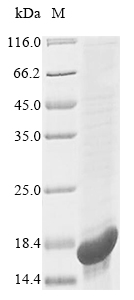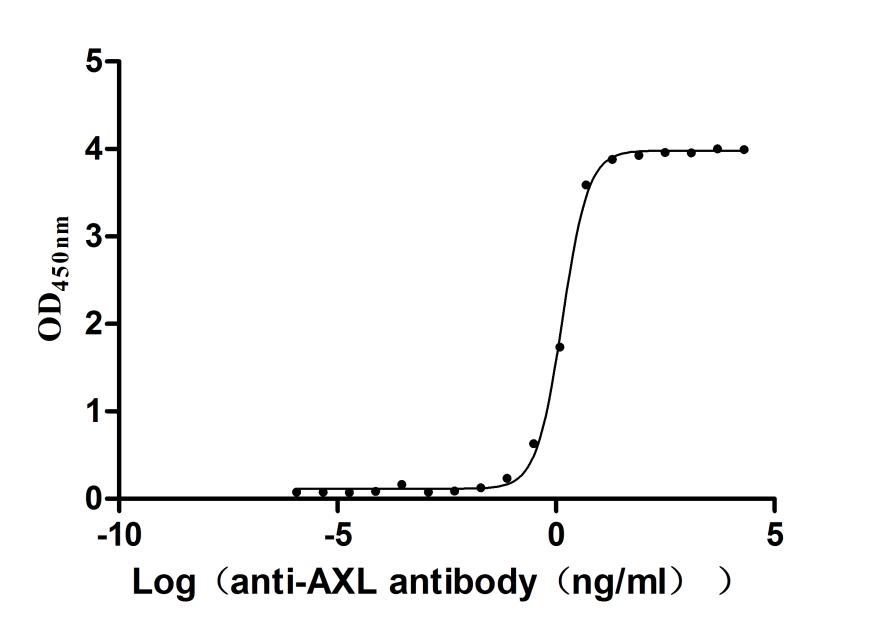Recombinant Candida glabrata Autophagy-related protein 8 (ATG8)
-
中文名称:
-
货号:CSB-EP739788CZI
-
规格:¥2,328
-
图片:
-
其他:
产品详情
-
纯度:Greater than 90% as determined by SDS-PAGE.
-
基因名:ATG8
-
Uniprot No.:
-
种属:Candida glabrata (strain ATCC 2001 / CBS 138 / JCM 3761 / NBRC 0622 / NRRL Y-65) (Yeast) (Torulopsis glabrata)
-
蛋白长度:Full Length
-
来源:E.coli
-
分子量:17.5 kDa
-
表达区域:1-116aa
-
氨基酸序列MKSSFKSEYPFEKRKAESERISEKFQNRIPVICEKAEKSDIPEVDKRKYLVPADLTVGQFVYVIRKRIMLPPEKAIFIFVNDTLPPTASLMSQVYQEHKDKDGFLYVTYSGENTFG
Note: The complete sequence including tag sequence, target protein sequence and linker sequence could be provided upon request. -
蛋白标签:N-terminal 6xHis-tagged
-
产品提供形式:Liquid or Lyophilized powder
Note: We will preferentially ship the format that we have in stock, however, if you have any special requirement for the format, please remark your requirement when placing the order, we will prepare according to your demand. -
缓冲液:If the delivery form is liquid, the default storage buffer is Tris/PBS-based buffer, 5%-50% glycerol. If the delivery form is lyophilized powder, the buffer before lyophilization is Tris/PBS-based buffer, 6% Trehalose.
-
复溶:We recommend that this vial be briefly centrifuged prior to opening to bring the contents to the bottom. Please reconstitute protein in deionized sterile water to a concentration of 0.1-1.0 mg/mL.We recommend to add 5-50% of glycerol (final concentration) and aliquot for long-term storage at -20℃/-80℃. Our default final concentration of glycerol is 50%. Customers could use it as reference.
-
储存条件:Store at -20°C/-80°C upon receipt, aliquoting is necessary for mutiple use. Avoid repeated freeze-thaw cycles.
-
保质期:The shelf life is related to many factors, storage state, buffer ingredients, storage temperature and the stability of the protein itself.
Generally, the shelf life of liquid form is 6 months at -20°C/-80°C. The shelf life of lyophilized form is 12 months at -20°C/-80°C. -
货期:Delivery time may differ from different purchasing way or location, please kindly consult your local distributors for specific delivery time.
-
注意事项:Repeated freezing and thawing is not recommended. Store working aliquots at 4°C for up to one week.
-
Datasheet & COA:Please contact us to get it.
相关产品
靶点详情
-
功能:Ubiquitin-like modifier involved in autophagosomes formation. With ATG4, mediates the delivery of the autophagosomes to the vacuole via the microtubule cytoskeleton. Required for selective autophagic degradation of the nucleus (nucleophagy) as well as for mitophagy which contributes to regulate mitochondrial quantity and quality by eliminating the mitochondria to a basal level to fulfill cellular energy requirements and preventing excess ROS production. Participates also in membrane fusion events that take place in the early secretory pathway. Also involved in endoplasmic reticulum-specific autophagic process and is essential for the survival of cells subjected to severe ER stress. The ATG8-PE conjugate mediates tethering between adjacent membranes and stimulates membrane hemifusion, leading to expansion of the autophagosomal membrane during autophagy.
-
亚细胞定位:Cytoplasmic vesicle, autophagosome membrane; Lipid-anchor. Vacuole membrane; Lipid-anchor.
-
蛋白家族:ATG8 family
-
数据库链接:
KEGG: cgr:CAGL0A04675g
STRING: 284593.XP_444971.1
Most popular with customers
-
Recombinant Human Glypican-3 (GPC3) (G537R), partial (Active)
Express system: Mammalian cell
Species: Homo sapiens (Human)
-
Recombinant Mouse Retinol-binding protein 4 (Rbp4) (Active)
Express system: Mammalian cell
Species: Mus musculus (Mouse)
-
Recombinant Human Tomoregulin-2 (TMEFF2), partial (Active)
Express system: Mammalian cell
Species: Homo sapiens (Human)
-
Recombinant Human CD81 antigen (CD81), partial (Active)
Express system: Mammalian cell
Species: Homo sapiens (Human)
-
Recombinant Macaca fascicularis Zinc transporter ZIP6 isoform X1(SLC39A6),partial (Active)
Express system: Baculovirus
Species: Macaca fascicularis (Crab-eating macaque) (Cynomolgus monkey)
-
Recombinant Human Tyrosine-protein kinase receptor UFO(AXL),partial (Active)
Express system: Mammalian cell
Species: Homo sapiens (Human)



-AC1.jpg)















